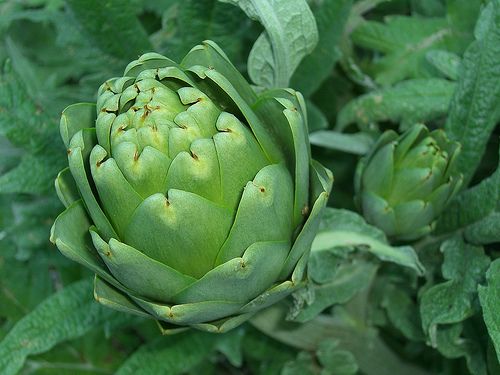
Artichokes are not as popular to grow in the home garden as tomatoes, but the hype is huge at the dinner table. I’m conducting an experiment to see how many of you will add artichokes to your garden plant list to start at the end of winter this season. First, I have some historical reference for you artichoke lovers, and Italy plays the biggest role in my story.
Anything to do with Italy is utterly fascinating to me partly because I’m Italian and partly because I’ve seen Under the Tuscan Sun several times. It doesn’t really matter because everyone knows no one does it better than Italians when it comes to food and cars. Man, what Italians do for cars—am I right?
So here’s the deal. More than 3,000 years ago, all the foodies of the world were munching on artichokes—until Rome took the big bite in the dust. Rome falls and artichokes are forgotten. Go figure. Around the middle of the 15th century, with a quick palm-to-the-forehead, some Italian peasant remembers the thistly food plant around 2 AM (isn’t that always the way), and the resurrection of the artichoke has begun.
At this point a lovely Italian princess, Catherine Di Medici, only 14 years old, is married to King Henry II. While it smacks of repulsive behavior, the king was only 14 years old himself. (Actually, I don’t think he was king when he was 14, but I digress). Anyway, Catherine, responsible for many a key role in France’s history, was less known for bringing her beloved artichokes from her home in Italy to her new home in France. Both French as well as Italian explorers had them aboard their ships and, bada-bing, bada-boom—America has a love affair with them and invents mayonnaise.
A few artichoke-growing facts
The thing about these thistles is that they’re most easily grown in a warm climate as a perennial or biennial. They can also be grown as an annual in cold climates if they are tricked into thinking they are two years old instead of only one year old.
These Mediterranean plants make themselves quite at home in places like the California coastline, where they all but flourish. If you live in USDA Zones 8–11, you’re in luck. They’ll grow as the perennials they were always intended to be. They prefer a pH range of anywhere from 6.5 to 8.0 and want full (that’s eight hours) of sunshine. They require deep watering and are fairly heavy feeders, so compost their bed like crazy.
As far as varieties, ‘Green Globe’ has been the most popular plant to grow; however, the newer kid in town is called ‘Imperial Star’ and is supposed to produce three times more than the oldie but goodie.
If you’ve seriously never tried artichokes, get thee to the produce department of Whole Foods immediately. Plain old mayonnaise tastes absolutely wonderful on the ends of their tender leaves. That said, there are many recipes for different mayos, such as basil mayo, lemon mayo, and balsamic vinegar mayo. You can also stuff artichokes with bread crumbs and butter.
Most artichokes are prepared simply by cooking them in a large covered pot of salted boiling water. It takes about 30 to 45 minutes for them to become tender when pierced with a fork or knife. When you take them out of the boiling water, you turn them upside down onto paper towels to drain thoroughly. You can cook artichokes a day early if you’d like, and fancy-shmancy chefs like to snip off the tips of all the leaves before cooking them to make them look, well, fancy-shmancy.
Perhaps the most well-known part of the artichoke is the delicacy known as the artichoke heart. Even when people don’t want to bother with dipping the external leaves into butter or mayo and scrape them along their bottom teeth to get the flesh, they’ll eat nearly anything that has the nutty-flavored hearts in it.
Simple basil mayo recipe
• 1 cup mayonnaise
• ¼ cup chopped fresh basil
• 1 tablespoon fresh lemon juice
• 1 garlic clove, minced
Fine Gardening Recommended Products

Corona High Performance Orchard Loppers
Fine Gardening receives a commission for items purchased through links on this site, including Amazon Associates and other affiliate advertising programs.

Ashman Garden Cultivator (1Pack)
Fine Gardening receives a commission for items purchased through links on this site, including Amazon Associates and other affiliate advertising programs.

The New Organic Grower, 3rd Edition: A Master's Manual of Tools and Techniques for the Home and Market Gardener, 30th Anniversary Edition
Fine Gardening receives a commission for items purchased through links on this site, including Amazon Associates and other affiliate advertising programs.






















Comments
Log in or create an account to post a comment.
Sign up Log in